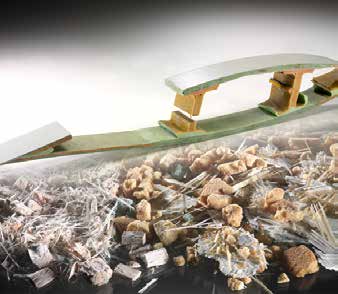Recycling of Large-Scale Composite Components – Rotor Blades
Composites made of reinforced fibers with thermosetting polymers as a matrix material have been the center of new material developments for a number of years, due to their enormous lightweight construction potential and high economic efficiency. Composites are increasingly being incorporated into new products and, consequently, large quantities of these materials will need to be recycled in the future. In addition to fiber-reinforced polymers, filling materials like balsa wood or polymer foam as a sandwich construction are applied to the rotor blades of wind turbines to save additional weight. The advantage of hybrid materials – that, with the right mix of materials in the composite, they can be adapted to individual requirements – has turned out to be a disadvantage with regard to disposal. The recycling of these composite materials, and in particular the separation of the components without forfeiting the desirable properties, is still an unresolved problem.
The development of an economical and ecological recycling solution for composites must take into account the entire recycling chain, from dismantling and treatment through to the provision of processable secondary raw materials. However, these steps prove to be difficult, particularly with large-scale components like rotor blades. With today’s state-of-the-art technology, dismantling only enables the transport of rotor blade segments that do not require authorization. It does not serve the purpose of separating them into individual fractions. Rotor blades currently requiring disposal are made of glass-fiber-reinforced polymers containing a polymer foam or basal wood sandwich construction. Large metal bolts are located at the flange, which connects the rotor, and copper lines are contained inside the blades to act as lightning conductors. Some manufacturers also integrate carbon-fiber-reinforced polymers into particularly stressed areas in some of the latest generation of rotor blades. Current research work also focuses on the application of thermoplastic structures in rotor blades, which further contributes to the existing material mix. A separation of individual fractions at the contact point would make the subsequent processing and material recovery more efficient. Up to now, the recycling process for rotor blade materials was a mechanical shredding of the entire composite, which was then used as a combustible or sand substitute in the cement industry, or for thermal recovery in waste incineration plants.
The use of energetic dismantling to separate rotor blade materials into different fractions, as well as the subsequent material-specific processing, are being researched at Fraunhofer ICT within the framework of the ForCycle project on “Recycling of Composite Components made of Polymers as Matrix Material”. The objective of the project is the recovery of secondary raw materials for renewed, high-quality application. The technological possibilities for recovering fiber material comprise mechanical, thermal and also chemical processes. In cooperation with the Technische Hochschule Nürnberg, the separation of fibers from the matrix material is researched in addition to the recovery of these resins and fillers, in order to achieve an ecologically and economically efficient recycling process. The sustainability of the new developments is shown in a final evaluation of the new processes and materials as well as through a comparison with the state of the art in the recycling of rotor blades.
 Fraunhofer Group for Materials and Components - Materials
Fraunhofer Group for Materials and Components - Materials